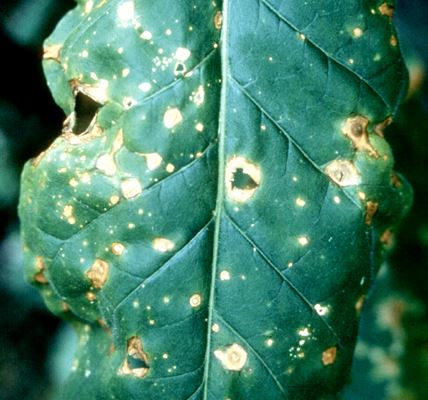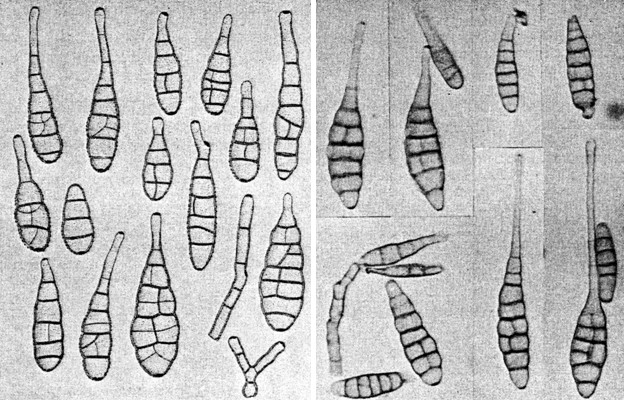Alternaria longipes (brown spot)
Identity
- Preferred Scientific Name
- Alternaria longipes (Ellis & Everh.) E.W. Mason
- Preferred Common Name
- brown spot
- Other Scientific Names
- Alternaria brassicae var. tabaci Preissecker (1909)
- Alternaria tenuis f.sp. tabaci Lloyd (1971)
- Macrosporium longipes Ellis & Everh. (1892)
- International Common Names
- EnglishAlternaria leaf spot
- Spanishtizon temprano del tabaco
- Frenchtaches brunes du tabac
- Local Common Names
- GermanyBraunfleckenkrankheit: Tabak
- EPPO code
- ALTELO (Alternaria longipes)
Pictures

A. longipes on tobacco
The first symptoms of brown spot disease are small, circular, dark-brown lesions on the lower leaves of field plants and sometimes on old seedlings or the senescing leaves of transplants. The lesions enlarge as the leaves mature and are surrounded by an irregular, yellow halo.
CTC/Zeneca

Symptoms on leaf
Tobacco brown spot on tobacco leaf caused by A. longipes.
©J.M. Waller/CABI BioScience

Conidia and conidiophores
Conidia and conidiophores x 500. CMI Descriptions of Pathogenic Fungi and Bacteria No. 245. CAB International, Wallingford, UK. Photo by D W Fry.
CAB International
Distribution
Host Plants and Other Plants Affected
| Host | Host status | References |
|---|---|---|
| Avena sativa (oats) | Unknown | Hekimhan et al. (2021) |
| Camellia sinensis (tea) | Unknown | Yin et al. (2021) |
| Daucus carota (carrot) | Other | Vintal et al. (2002) |
| Elaeis guineensis (African oil palm) | Other | |
| Helianthus annuus (sunflower) | Other | |
| Medicago sativa (lucerne) | Unknown | Maiti et al. (2007) |
| Nicotiana tabacum (tobacco) | Main | Rashtra (2017) |
| Quercus griffithii | Unknown | Ng and Chhetry (2006) |
| Quercus serrata (glandbearing oak) | Unknown | Ng and Chhetry (2006) |
| Scaevola taccada (beach naupaka) | Unknown | Wang et al. (2021) |
| Smilax china (Chinaroot) | Other | Long et al. (2009) |
| Solanum tuberosum (potato) | Other | Shoaib et al. (2014) |
Symptoms
The first symptoms of brown spot disease are small, circular, dark-brown lesions on the lower leaves of field plants and sometimes on old seedlings or the senescing leaves of transplants. The lesions enlarge as the leaves mature and are surrounded by an irregular, yellow halo. The halo is caused by the secretion of toxins. Often there are numerous lesions, about 25 mm in diameter, which may coalesce and affect more than 80% of the leaf area. Large lesions may have numerous small, satellite circular lesions in their vicinity, arising from conidia washed off the main lesion.Infected leaves senesce prematurely and the affected part of a leaf may be yellow when the rest is dark green. A uniform infection, covering up to about 10% of leaf area, in slow ripening conditions, can accelerate ripening and increase the value of the harvested leaves because buyers assess them as being more mature than clean leaves that were reaped at the same time.Lesions on midribs and stems are elliptical, sunken, very dark brown and do not have yellow haloes. They can be numerous in intense inoculum pressure.Seeds taken from infected capsules can have infected debris and spores adhering to them.ToxinsTenuazonic acid (TA), a host-specific toxin, can be isolated from culture filtrates of A. longipes and from infected leaves. Researchers in Japan found that TA produced haloes identical to those on infected leaves and suggested that TA might be used to screen for resistance (Mikami, 1972; Mikami et al., 1971a, b). Disease susceptibility and toxin sensitivity were closely correlated in tests with seven cultivars.
List of Symptoms/Signs
| Symptom or sign | Life stages | Sign or diagnosis |
|---|---|---|
| Plants/Leaves/abnormal colours | ||
| Plants/Leaves/necrotic areas | ||
| Plants/Seeds/discolorations | ||
| Plants/Seeds/lesions on seeds | ||
| Plants/Stems/discoloration of bark |
Prevention and Control
Host-Plant Resistance
The cigar cultivar Beinhardt 1000-1 has field resistance to brown spot. It has been used as a source of resistance by tobacco breeders, but success has been limited in flue-cured tobacco because it is difficult to separate the resistance from cigar flavours. Lapham (1976) bred another cultivar, Banket A1, from Beinhardt and it is now commercially grown in Zimbabwe. Other cultivars with various amounts of resistance are Gwancho (Shin, 1976), Kokubun, Matsukawa, Osibeubtchio, Gwangtchio and Hoetchio (Park et al., 1977).
Chemical Control
Anilazine has been tested for the field control of A. longipes, with promising results (Lucas, 1961; Hartill and Gates, 1966). However, the economic benefits of control depended on the severity of the disease and the amount of fungicide required to regulate infection to less than 10% of the leaf area. A rectangular hyperbola equation fitted the field data on the relation between monetary return and anilazine dosage (Cole and Zvenyika, 1982). The potential monetary benefit from sprays increased with dosage, but the expected return per unit of fungicide applied decreased steadily. The most economic dosage is not necessarily the one that gives maximum disease control. Spray application methods were researched by Hartill (1968) and Cole and Zvenyika (1978).In Zimbabwe, iprodione, anilazine and tebuconazole are used to control brown spot in the field (Fisher et al., 1993).Because tobacco heavily infected with root-knot nematodes frequently has large amounts of brown spot, Lucas (1975) recommends nematode control as a control measure for brown spot.
Cultural Control
A. longipes survives on infected plant residues, in dry soil, and new plant infections start from these foci. Contaminated seed that has not been surface sterilized can also be a source of infection.Phytosanitary and cultural practices are documented by Hartill (1968) and Ellis and Holiday (1970). The three most important methods are: the removal or deep burial of infected plant material when the crop has been harvested; seed treatment to remove debris; and balanced fertilization of the tobacco crop.
Impact
Main et al. (1972) described a comprehensive brown spot assessment programme to evaluate the economic effects of the disease. Cole and Zvenyika (1982) reported that yield and price per kg of saleable tobacco in brown spot epidemics decreased linearly with infection index, based on leaf area damaged. Yield loss varied with the degree of infection; 809 kg/ha of saleable tobacco was lost in one trial in Zimbabwe (Cole and Zvenyika, 1982) and 258 kg/ha in the USA (Lucas, 1961).Lucas (1975) reviewed the economic importance of brown spot in the tobacco-producing regions of the USA. In 1956, the estimated crop loss in North Carolina was US$10 million and in subsequent years it ranged between $2.4 million and $21 million. The estimates were made by summarizing the assessments of county extension agents.Brown spot disease also changes the chemical composition of cured leaves (Main et al., 1973). The sugar concentration decreased linearly with the natural log of leaf infection. The physical characteristics of cured tobacco are also affected. Main and Chaplin (1972) found that filling value, which determines the number of cigarettes that can be made per kg of tobacco, and shatter, which affects the amount of waste, were adversely affected by increasing amounts of brown spot.
Information & Authors
Information
Published In
Copyright
Copyright © CABI. CABI is a registered EU trademark. This article is published under a Attribution-NonCommercial-NoDerivatives 4.0 International (CC BY-NC-ND 4.0)
History
Published online: 25 February 2023
Language
English
Authors
Metrics & Citations
Metrics
SCITE_
Citations
Export citation
Select the format you want to export the citations of this publication.
EXPORT CITATIONSExport Citation
View Options
View options
Get Access
Login Options
Check if you access through your login credentials or your institution to get full access on this article.


